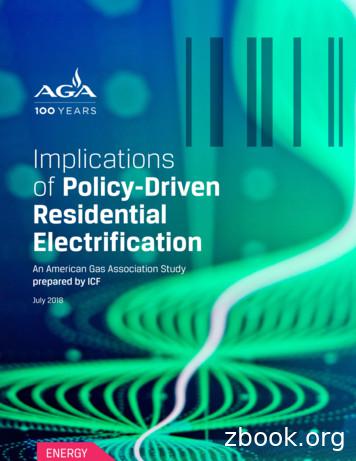Final Draft 2020 Transportation Electrification Forecast - ISO New England
FEBRUARY 18, 2020 Final Draft 2020 Transportation Electrification Forecast Load Forecast Committee Jon Black MANAGER, LOAD FORECASTING ISO-NE PUBLIC
Introduction ISO discussed methodology and assumptions used in the transportation electrification forecast at the September 27, 2019 and November 18, 2019 LFC meetings, and the draft 2020 forecast at the December 20, 2019 LFC meeting The 2020 transportation electrification forecast focuses on light-duty vehicles (LDV), including cars and light-duty trucks – Electrification of other, non-LDV vehicle classes (e.g., freight vehicles, electric buses, rail, trolley) may be considered in future forecasts There are two general components to the EV forecast: 1. 2. Forecast the adoption of electrified LDVs for each state and the region over the next ten years Adoption values to include battery-electric vehicles (BEV) and plug-in hybrid electric vehicles (PHEV) Data-driven assumptions to convert the EV adoption forecast into estimated impacts on monthly energy and demand by state Include monthly demand and energy impacts per EV based on recent historical EV charging data licensed from ChargePoint, Inc. ISO-NE PUBLIC 2
Stakeholder Comments on Draft Forecast VT Department of Public Service – The current forecast is a reasonable first iteration, but likely overstates demand impacts when considering load control strategies that may be implemented No changes were made to the 2020 forecast based on stakeholder comments ISO-NE PUBLIC 3
Update on EIA Annual Outlook Forecast EIA released the 2020 AEO on January 29, 2020 – – Comparison of the past 4 AEO projections of New England BEV/PHEV sales is plotted to the right – Forecast includes significantly lower BEV/PHEV sales projections Change is primarily due to EIA’s removal of California’s zero emission vehicle (ZEV) Mandate from light-duty vehicle modeling 2020 AEO is lowest through year 2035 The AEO 2019 forecast that previously discussed with stakeholders will be used as the final 2020 EV adoption forecast – Increased EV adoption better aligns with New England state policy objectives Annual BEV/PHEV Sales in New England (EIA) 120,000 2020 AEO 100,000 2019 AEO 2018 AEO 80,000 2017 AEO 60,000 40,000 20,000 - 2020 ISO-NE PUBLIC 2025 2030 2035 2040 4
Final Draft 2020 EV Adoption Forecast 2019 Annual Energy Outlook Forecast (EIA Reference Case) Forecast of EV LDV sales for New England Incremental sales from 2020-2029 tabulated for use in 2020 draft forecast Allocated to states based on state shares of 2018 EV registrations Year 2020 2021 2022 2023 2024 2025 2026 2027 2028 2029 Estimated Total NE CT MA ME NH RI VT 35,653 43,199 47,020 49,783 53,005 55,737 55,921 57,136 58,032 60,197 515,683 8,449 10,237 11,143 11,798 12,561 13,209 13,252 13,540 13,753 14,266 122,208 18,329 22,209 24,173 25,594 27,250 28,655 28,750 29,374 29,835 30,948 265,119 2,181 2,642 2,876 3,045 3,242 3,409 3,420 3,495 3,549 3,682 31,540 2,672 3,238 3,524 3,731 3,973 4,177 4,191 4,282 4,349 4,512 38,649 1,499 1,816 1,976 2,092 2,228 2,343 2,351 2,402 2,439 2,530 21,675 2,523 3,057 3,327 3,523 3,751 3,944 3,957 4,043 4,107 4,260 36,492 ISO-NE PUBLIC 5
EV Fleet Turnover EV fleet turnover assumptions: – 50% of sales turn over after 8 years – 25% of sales turn over after 9 years – 25% of sales turn over after 10 years Effect of assumed turnover is illustrated for the draft 2020 New England EV forecast ISO-NE PUBLIC 6
Final Draft 2020 EV Forecast Monthly Energy ISO-NE PUBLIC 7
Final Draft 2020 EV Forecast Monthly Demand ISO-NE PUBLIC 8
Final Draft 2020 EV Forecast Winter Demand (January) ISO-NE PUBLIC 9
Final Draft 2020 EV Forecast Summer Demand (July) ISO-NE PUBLIC 10
Next Steps ISO will publish the transportation electrification forecast as part of CELT 2020 – Will be included in both the CELT report and the annual Forecast Data spreadsheet ISO-NE PUBLIC 11
APPENDIX Information Supporting Assumptions Used in the 2020 Transportation Electrification Forecast ISO-NE PUBLIC 12
EV Adoption Forecast Using Registration and New Sales Data in EV Adoption Forecast Tabulated to the right are 2018 total LDV registrations and new LDV sales data from Alliance of Automobile Manufacturers Based on these data, below are related state-level statistics on BEV/PHEV registrations and new sales – – Registration data/calculations is shaded blue Sales data/calculations are shaded orange State shares of regional BEV/PHEVs (in dashed red box) are used to convert regional EIA adoption forecast to state forecasts State CT MA ME NH RI VT NE BEV PHEV Registrations (2018) 9,799 21,258 2,529 3,099 1,738 2,926 41,349 State Share of Region 23.7% 51.4% 6.1% 7.5% 4.2% 7.1% 100.0% State CT MA ME NH RI VT NE 2018 Registrations BEV PHEV Total LDVs 4,453 5,346 3,052,626 9,763 11,495 5,382,570 748 1,781 1,287,077 1,125 1,974 1,306,353 599 1,139 859,116 1,057 1,869 564,886 17,745 23,604 12,452,628 State Share of Total LDV Registrations 0.32% 0.39% 0.20% 0.24% 0.20% 0.52% 0.33% ISO-NE PUBLIC BEV PHEV New Purchases (2018) 3,415 8,990 799 1,123 619 824 15,770 2018 New Purchases BEV PHEV Total LDVs 1,844 1,571 169,074 4,959 4,031 355,731 254 545 70,462 579 544 97,069 276 343 49,166 355 469 42,913 8,267 7,503 784,415 BEV PHEV Share of Total New LDV Purchases 2.0% 2.5% 1.1% 1.2% 1.3% 1.9% 2.0% 13
Estimating Energy Impacts of EV Adoption Monthly energy is based on results of the ChargePoint data analysis The adjacent bar chart illustrates monthly kWh/day per EV used to estimate monthly energy Values reflect a 6% gross-up for assumed transmission and distribution losses Data source: ChargePoint, Inc. ISO-NE PUBLIC 14
Estimating Demand Impacts of EV Adoption Hourly weekday EV demand profiles are used to estimate demand impacts – These values reflect the 75th percentile (“P75”) of the aggregated hourly EV data discussed as part of the November 18, 2019 LFC (slides 11-19) P75 values serve to capture more extreme values than averages (e.g., due to weather effects), but are not the most extreme data points, which could be more of an artifact of a relatively small EV sample size Demand estimates are grossed up by 8% for assumed transmission and distribution losses, consistent with other forecast processes Resulting weekday demand profiles are shown on the following slide (all values reflect 8% gross-up) ISO-NE PUBLIC 15
EV Hourly Demand Weekday EV Profiles For applications that include hourly analysis, EV demand will be modeled hourly – E.g., probabilistic ICR analysis Other forecast applications and reporting require a deterministic peak value (e.g., CELT report), and for which: – Winter peak demand: – Use the monthly average EV demand from HE 18-19 January-April, OctoberDecember Summer demand impacts should reflect expectations of peak shifting due to increasing BTM PV penetrations (see next 2 slides) Data source: ChargePoint, Inc. ISO-NE PUBLIC 16
Summer Peak Net Load as BTM PV Increases Hourly net load and BTM PV data from the summers (July/August) of 2014-2019 were analyzed to simulate net loads with increasing penetrations of BTM PV Scatter plot shows the hour ending (HE) and magnitude (in GW) of net peak load as BTM PV increases Gray areas reflect estimated window of hours peak load may occur – Yellow areas highlight peak hours ISO-NE PUBLIC 17
Interaction of EV Summer Demand and BTM PV For forecast applications and reporting that require a deterministic peak value, EV demand during the summer months is estimated as the average monthly EV demand during the summer peak hours tabulated to the right – May through September – Hours reflect effect of shifting peak demand due to BTM PV ISO-NE PUBLIC Year PV Nameplate Summer Peak Bin (GW) * Hours 2020 3 16, 17, 18, 19 2021 4 16, 17, 18, 19 2022 4 16, 17, 18, 19 2023 5 17, 18, 19 2024 5 17, 18, 19 2025 5 17, 18, 19 2026 6 17, 18, 19 2027 6 17, 18, 19 2028 6 17, 18, 19 2029 7 17, 18, 19 * Based on 2019 PV Forecast values 18
ISO-NE PUBLIC 19
Final Draft 2020 EV Forecast Winter Demand (January) 9. ISO-NE PUBLIC Final Draft 2020 EV Forecast Summer Demand (July) 10. ISO-NE PUBLIC 11 Next Steps ISO will publish the transportation electrification forecast as part of CELT 2020 - Will be included in both the CELT report and the annual Forecast Data
Electrification of Industry: Summary of Electrification Futures Study Industrial Sector Analysis Author: Colin McMillan Subject: This presentation provides context for electrification of the industrial sector and summarizes industrial analysis performed for the Electrification Futures Study. Created Date: 9/20/2018 10:30:39 AM
developed scenarios of electrification for each end-use sector based on exogenously defined rates of electrification and efficiency improvements for each end-use service. We then employ a highly detailed power sector model to study the impacts of electrification on the
through large-scale resources and use distributed solar. 2. Accelerate electrification of the transportation sector, including placing at least 7 million light-duty passenger vehicles on the roads and supporting a transition to zero-emission trucks and transit. 3. Increase electrification of buildings: electrify nearly one-third of residential .
Final Date for TC First Draft Meeting 6/14/2018 3/15/2018 Posting of First Draft and TC Ballot 8/02/2018 4/26/2018 Final date for Receipt of TC First Draft ballot 8/23/2018 5/17/2018 Final date for Receipt of TC First Draft ballot - recirc 8/30/2018 5/24/2018 Posting of First Draft for CC Meeting 5/31/2018 Final date for CC First Draft Meeting .
Fluid Power Pumps and the Electrification With a Focus on Discrete Displacement Control in Load Handling Applications Samuel Kärnell Linköping Studies in Science and Technology Licentiate Thesis No. 1882 Samuel Kärnell Fluid Power Pumps and the Electrification 2020
residential electrification would range between 572 and 806 per metric ton of CO 2 reduced, which is significantly higher than the estimated cost of other GHG reduction options. The costs and impacts from the residential electrification policy modelled in the study vary widely by region. based on differences in weather, which
Secular Trends Vehicle Electrification ELECTRIFICATION Increasing electrification of the powertrain from mild HEV's to full HEV's, PHEV's and EV's, A E . Mobility 3.3 4.2 0% Networking & Storage 2.8 2.8 (7%) Total Revenue 13.2 15.4 16.9 Total Revenue 14.1 13.9 14.6 Core Operating Margin* 3.7% 4.8% 5.0% Core Operating Margin*
ISO 14001:2004 and ISO 9001:2000 15 Annex B (informative) Correspondence between OHSAS 18001, OHSAS . Standard vi List of tables Table A.1 – Correspondence between OHSAS 18001:2007, ISO 14001:2004 and ISO 9001:2000 15 Table B.1 – Correspondence between the clauses of the OHSAS documents and the clauses of the ILO-OSH Guidelines 20 Summary of pages This document comprises a front cover .























